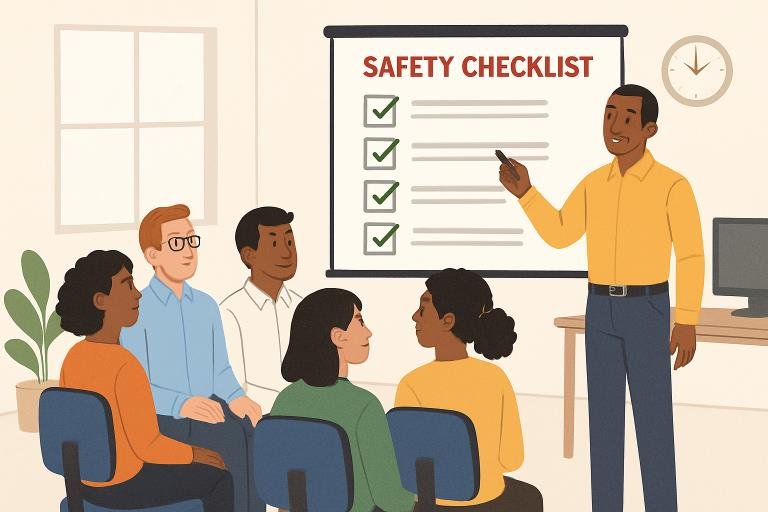Key Takeaways
- Workplace violence is a growing concern across various industries, necessitating proactive prevention strategies.
- Comprehensive training programs are essential for equipping employees with the skills to recognize and respond to potential threats.
- Implementing clear policies and fostering a safety culture can significantly reduce the risk of violent incidents.
- Regular assessments and updates to safety protocols ensure ongoing effectiveness in violence prevention.
Cultivating secure workplaces is paramount, and comprehensive education plays a vital role. Effective programs equip employees with the knowledge and skills to identify, prevent, and respond to aggressive behaviors. This training typically covers recognizing warning signs, de-escalation techniques, reporting procedures, and understanding company policies. The goal is to foster a proactive safety culture where individuals feel empowered to address potential threats and protect themselves and their colleagues. Such initiatives mitigate risks and enhance employee well-being and productivity by ensuring everyone feels safe and respected. Investing in these preventative measures is crucial for any organization committed to safeguarding its team.
Understanding the Scope of Workplace Violence
Workplace violence encompasses a spectrum of behavior, from verbal threats and bullying to physical assaults that can have devastating consequences. The issue is pervasive in public and private sectors, but some industries, such as healthcare, social services, and retail, are particularly vulnerable. The Bureau of Labor Statistics reports that healthcare workers face workplace violence at a rate five times higher than the average for all private industries. Given these alarming statistics, organizations must recognize the urgent need for workplace violence training courses for companies to empower employees and mitigate potential risks from the outset.
Proactive organizations prioritize interventions to ensure employees’ physical and psychological safety. The American Hospital Association notes that ongoing education and preventative programs dramatically impact the overall level of reported incidents, demonstrating the value of formal training and prevention plans.
The Importance of Comprehensive Training Programs
Preventing workplace violence requires more than a one-time safety briefing. Comprehensive training programs must educate employees and supervisors on identifying warning signs—such as sudden changes in behavior, increased conflicts, or known risk factors—and respond appropriately. Practical training provides instruction in conflict resolution, de-escalation strategies, and active shooter or emergency procedures, all tailored to the unique contexts of an organization’s operations. The National Safety Council highlights that immersive learning solutions, such as virtual reality simulations, are proving valuable for preparing employees for potential real-life situations without risk.
Investing in high-quality training also ensures that everyone in the organization knows how and when to report concerns confidentially. Consistent, actionable education builds confidence and promotes early intervention—key factors in preventing escalation and harm.
Developing Clear Policies and Procedures
Organizations should establish a written Workplace Violence Prevention Plan (WVPP) outlining preventive measures, employee rights, and reporting procedures. This plan must be updated regularly and integrated into overall safety management systems. A strong WVPP includes guidance on responding to threats, managing incidents, and post-incident support for individuals affected by violence. According to the Occupational Safety and Health Administration (OSHA), clear policies help ensure accountability at all levels and create shared understanding of zero-tolerance principles for violent behavior.
Policy provisions should also detail emergency response roles, communication protocols, and the use of available protective technologies such as access controls or panic alarms. Frequent policy reviews ensure the procedures align with evolving risks and industry best practices.

Fostering a Culture of Safety
Redefining workplace culture starts at the top. Leadership engagement is essential to foster trust and demonstrate a deep commitment to safety. Management must encourage open lines of communication so employees feel confident raising security concerns without fear of retaliation. The American Hospital Association’s “Building a Safe Workplace and Community” framework stresses the significance of senior leaders engaging directly in safety programs and supporting staff who report hazardous conditions.
Regular town halls, anonymous feedback channels, and visible recognition for safety-minded behavior reinforce the message that everyone has a right to a respectful and secure work environment. Organizational support resources, such as employee assistance programs (EAPs), help address the emotional and psychological effects of workplace threats and incidents.
Regular Assessments and Continuous Improvement
A dynamic approach to workplace safety means that protocols don’t remain static. Regular risk assessments, internal surveys, and interviews help organizations identify new hazards and refine prevention tactics. Incident data and employee feedback should be routinely reviewed to identify trends and gaps in the existing violence prevention strategy.
Continuous learning—updating training curricula in response to lessons learned and adapting to changes in workforce dynamics—supports long-term safety objectives. Organizations like the Society for Human Resource Management (SHRM) advocate for “after-action reviews” following any incident to inform future improvements and bolster resilience.
Legal and Regulatory Considerations
Compliance with laws and regulations is non-negotiable in effective workplace violence prevention. In California, for example, SB 553 requires employers to create, implement, and maintain a WVPP, deliver annual violence prevention training, and document all violent incidents. Understanding and following regulatory requirements protects organizations from legal consequences and reputational risk while fostering greater employee trust in management’s commitment to safety. Similar laws are emerging nationwide, underscoring the importance of staying current with evolving legislation through resources like OSHA’s workplace violence page.
Conclusion
Effectively tackling workplace violence requires a comprehensive strategy. This means implementing thorough training programs and strong policies, cultivating an open safety culture where concerns are heard, and committing to continuous improvement. When organizations prioritize these practices, they safeguard their staff, boost morale, increase productivity, and enhance their business reputation. By embedding safety into every aspect of their operations, companies establish a foundation for sustained success while fundamentally upholding their duty to protect their most invaluable resource: their employees.






